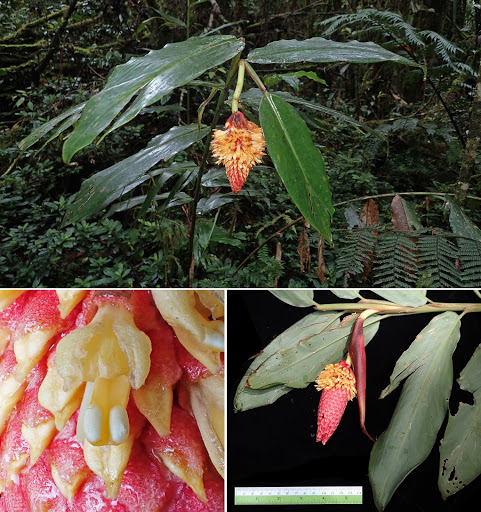 |
| Pleuranthodium sagittatum Lofthus & A.D.Poulsen. in Lofthus, Newman, Jimbo & Poulsen, 2020. |
Abstract
Three species of Pleuranthodium were encountered and collected during a survey of gingers at Mount Wilhelm, Chimbu Province, Papua New Guinea. Based on new material, the only previously known Pleuranthodium from this area, P. piundaundense, is described in more detail highlighting new diagnostic characters and its known distribution range is expanded based on identification of older specimens at Edinburgh from two other provinces. Two species so far only known from Mount Wilhelm could not be identified after studying all protologues, types and material from several herbaria. These are here described as new species, Pleuranthodium corniculatum and P. sagittatum. A key with both floral and vegetative characters is provided to all three species. Pleuranthodium corniculatum is distinct in having apical appendages on the calyx, and P. sagittatum has a wrinkled calyx. All species are described and illustrated, and conservation assessments are made.
Keywords: Chimbu; Pleuranthodium corniculatum; Pleuranthodium piundaundense; Pleuranthodium sagittatum; Zingiberaceae; taxonomy
Pleuranthodium corniculatum Lofthus &A.D.Poulsen, sp.
nov.
This species is distinguished from Pleuranthodium piundaundense (P.Royen)
R.M.Sm. by having a dark reddish brown calyx with at least 2 appendices at
the apex, dark reddish brown corolla lobes and a pale yellow-green labellum with reddish centre (vs pale yellow-green calyx lacking appendices,
pale orange-yellow corolla lobes and an orange labellum). The lamina has
strigose hairs on the veins beneath while the other species on Mt Wilhelm
are glabrous.
Etymology. The epithet is derived from the Latin diminutive, corniculata,
describing the presence of small horn-like structures, in this case on the
apex of the calyx.
Pleuranthodium piundaundense (P.Royen) R.M.Sm.
Etymology. The epithet refers to the Piundaunde valley with the two lakes
Piunde (c. 3600 m) andAunde (c. 3700 m) on the slopes of Mt Wilhelm above
the type locality.
 |
| Pleuranthodium sagittatum Lofthus & A.D.Poulsen. |
 |
| Pleuranthodium sagittatum Lofthus & A.D.Poulsen. close up of spike. — Photo by Axel Dalberg Poulsen. |
Pleuranthodium sagittatum Lofthus & A.D.Poulsen, sp. nov.
Similar to P. piundaundense in its yellow-orange flowers but differs by the shorter leafy shoots (1.6–1.8 m vs 3–4.1 m), the calyx being pale red and distinctly wrinkled (vs. pale yellow-green and smooth) and entire apex of the labellum (vs bilobed with a 3 mm incision).
Etymology. The epithet is derived from the Latin sagitta, which means arrow and refers to the vernacular name anger keneh yaundo that indicates the resemblance between the spike and an arrowhead.
Ethnobotany — During the collecting of the type of this
species the local guide, William Banda, gave the information
that this species is called anger keneh yaundo in the Kuman
language. This vernacular name is also used for P. piundaundense (see above), which has a similar pointed spike and the
leafy shoots are similarly used for the construction of bush hut
walls.
Ø. Lofthus, M.F. Newman, T. Jimbo and A.D. Poulsen. 2020. The Pleuranthodium (Zingiberaceae) of Mount Wilhelm, Papua New Guinea. Blumea - Biodiversity, Evolution and Biogeography of Plants. DOI: 10.3767/blumea.2020.65.02.01



